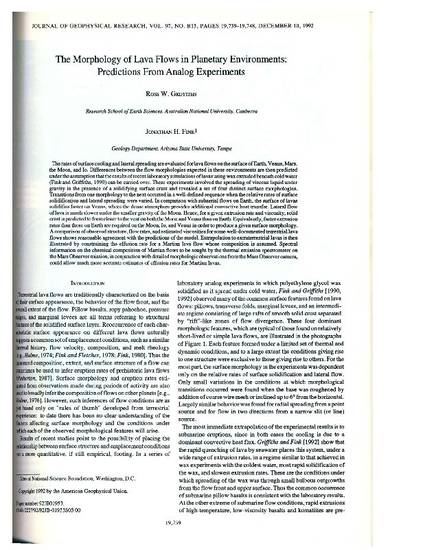
- Mars (Planet) -- Volcanoes,
- Mars (Planet) -- Geology -- Earth analogs,
- Venus (Planet) -- Volcanoes,
- Venus (Planet) -- Geology -- Earth analogs,
- Io (Satellite) -- Volcanoes,
- Io (Satellite) -- Geology -- Earth analogs,
- Planets -- Geology
- Geology and
- Volcanology
The rates of surface cooling and lateral spreading are evaluated for lava flows on the surface of Earth, Venus, Mars, the Moon, and 10. Differences between the flow morphologies expected in these environments are then predicted under the assumption that the results of recent laboratory simulations oflavas using wax extruded beneath cold water (Fink and Griffiths, 1990) can be carried over. These experiments involved the spreading of viscous liquid under gravity in the presence of a solidifying surface crust and revealed a set of four distinct surface morphologies. Transitions from one morphology to the next occurred in a well-defined sequence when the relative rates of surface solidification and lateral spreading were varied. In comparison with subaerial flows on Earth, the surface of lavas solidifies faster on Venus, where the dense atmosphere provides additional convective heat transfer. Lateral flow oflava is much slower under the smaller gravity of the Moon. Hence, for a given extrusion rate and viscosity, solid crust is predicted to form closer to the vent on both the Moon and Venus than on Earth. Equivalently, faster extrusion rates than those on Earth are required on the Moon, 10, and Venus in order to produce a given surface morphology. A comparison of observed structure, flow rates, and estimated viscosities for some well-documented terrestrial lava flows shows reasonable agreement with the predictions of the model. Extrapolation to extraterrestrial lavas is then illustrated by constraining the effusion rate for a Martian lava flow whose composition is assumed. Spectral information on the chemical composition of Martian flows to be sought by the thermal emission spectrometer on the Mars Observer mission, in conjunction with detailed morphologic observations from the Mars Observer camera, could allow much more accurate estimates of effusion rates for Martian lavas.

This is the publisher's final pdf. Originally published in: Journal of Geophysical Research (http://agupubs.onlinelibrary.wiley.com/agu/jgr/journal/10.1002/(ISSN)2156-2202/) and is copyrighted by American Geophysical Union (http://www.agu.org/)
*At the time of publication Jonathan Fink was affiliated with Arizona State University